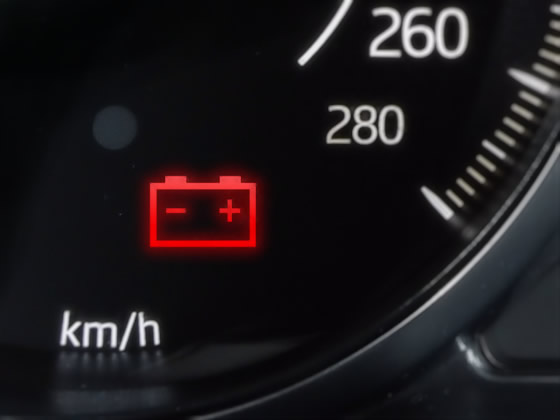Why is the Car Battery Warning Light on?
Under normal circumstances, the car battery warning light illuminates temporarily on the dashboard as you switch the ignition (or press the engine start button) to ‘on’ and then it should go out shortly after the engine has started. This is a bulb function check and the battery light goes out once the alternator starts producing sufficient charge.
However, there are reasons to be concerned if the:

- battery warning light stays on constantly after the engine has started
- battery warning light stays on longer than it used to
- battery warning light comes on while driving
- battery warning light comes on and off intermittently
- battery warning light flickers
If any of those examples apply to your vehicle, then there’s a problem – and it’s quite a common one.
Leading car breakdown services attend more call-outs due to battery related issues than any other fault. It’s the number one cause of vehicle breakdowns and is a especially common common in the winter.
Red battery warning light
Most cars have only the red battery warning light. If the red warning light comes on, it means the battery is no longer being charged due to a fault with the battery charging system.
Yellow battery warning light
Some vehicles may also be equipped with a yellow battery warning light. This is less serious and if the yellow battery warning light comes on, it means the battery has a low charge. This is often due to the vehicle being driven for mainly short trips only. Longer drives allow sufficient time for the alternator to charge the battery. If long drives really isn’t your thing, then consider leaving your battery on charge overnight. If either of those so not resolve the yellow battery warning light problem, then it could be a fault.
Common reasons why the car battery warning light is on include:
Battery
Your car battery is very busy powering the electrical systems in your vehicle. It’s constantly discharging and recharging and has many associated factors that influence the lifespan of your battery. On average, your car battery will last for about 4 to 5 years before it requires replacing.
Alternator
The alternator also called the generator produces electricity to power vehicle electrical components and to charge the battery when the engine is running. As with the battery, there are factors that determine how long an alternator will last. It’s an integral part of a vehicle’s charging system and if your alternator is older than 7 years or your vehicle has exceeded 100,000 miles, it could be the problem if your battery warning light is on.
Serpentine belt / alternator belt
The serpentine belt is a reinforced rubber belt that connects / runs various vehicle components in the engine compartment such as the alternator, air conditioning unit, water pump, power steering pump and the cooling fan (if it’s not electric). If the belt becomes excessively worn or breaks, all of those components including the alternator which charges the battery will cease to operate. Older serpentine belts last for around 50,000 miles whilst newer improved compound serpentine belts last for around 100,000 miles.
Battery terminals
Over time, the battery terminals may produce corrosion. The build up is easy to see and this corrosion can eventually restrict contact between the battery and the terminals. The terminals require removing and cleaning up with a wire brush.
Blown fuse / electrical fault
Check for any blown fuses that relate to the electrical system. Though you will need to find the cause of the blown fuse else the fault is likely to occur again. A qualified mechanic is able to check all these components listed above using specialist equipment.
| More about the Car Battery |
|---|
